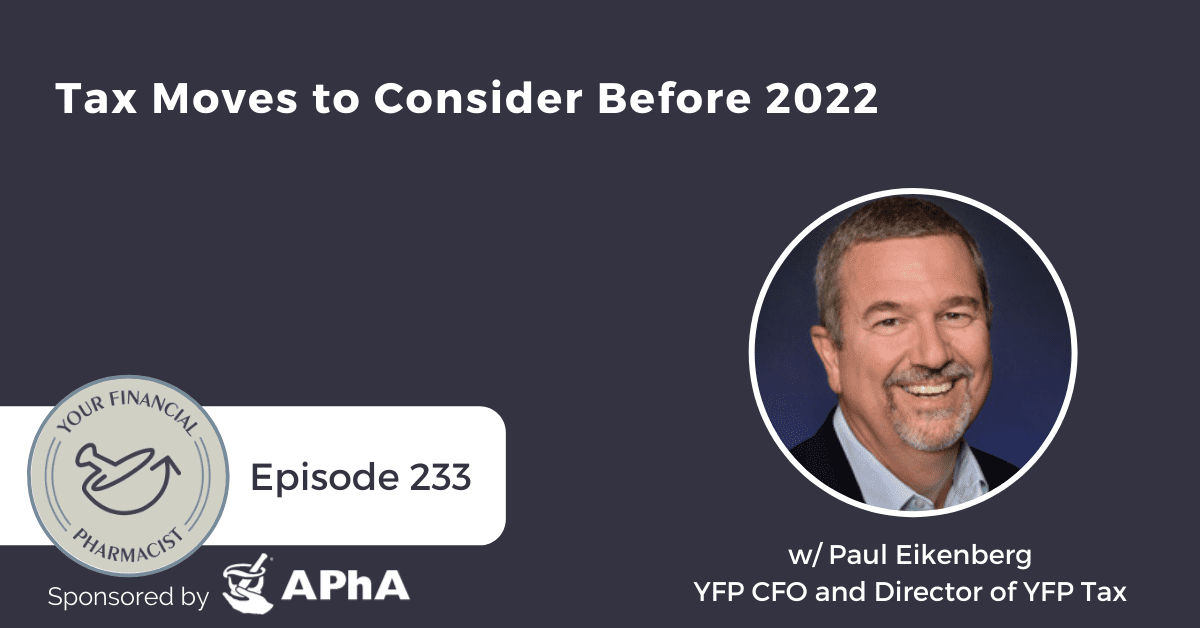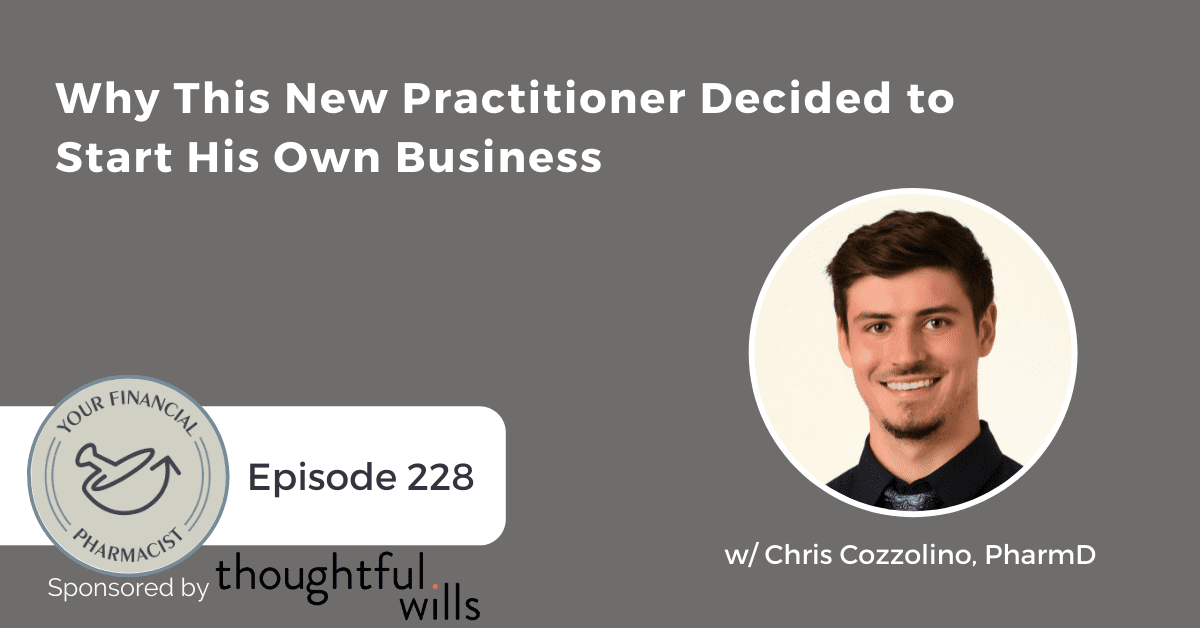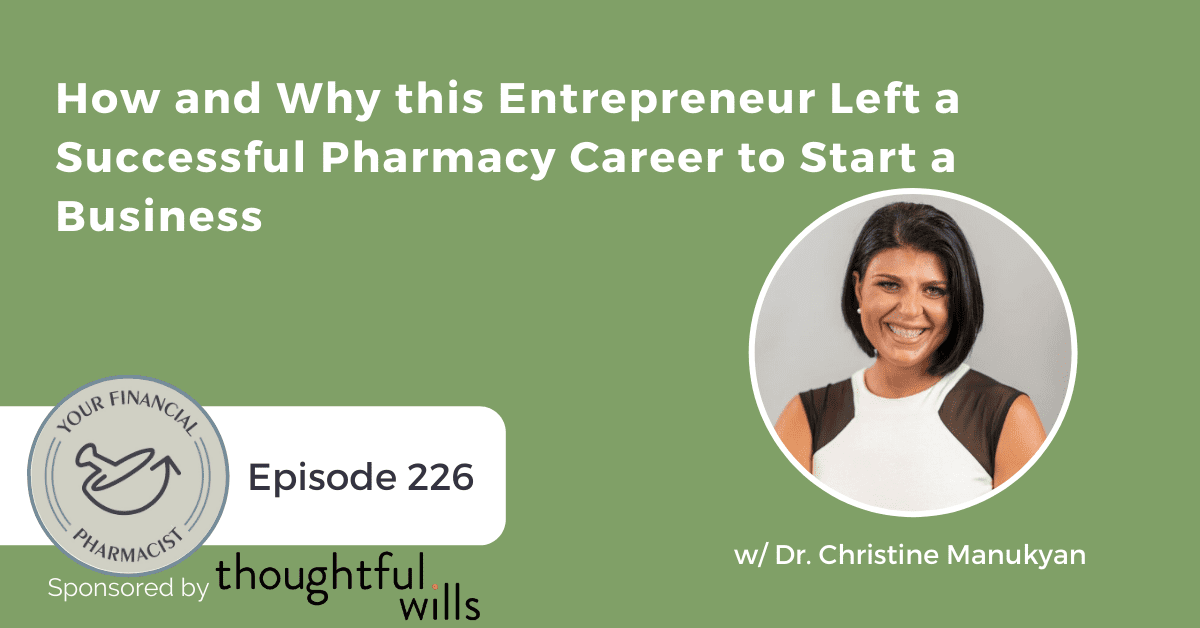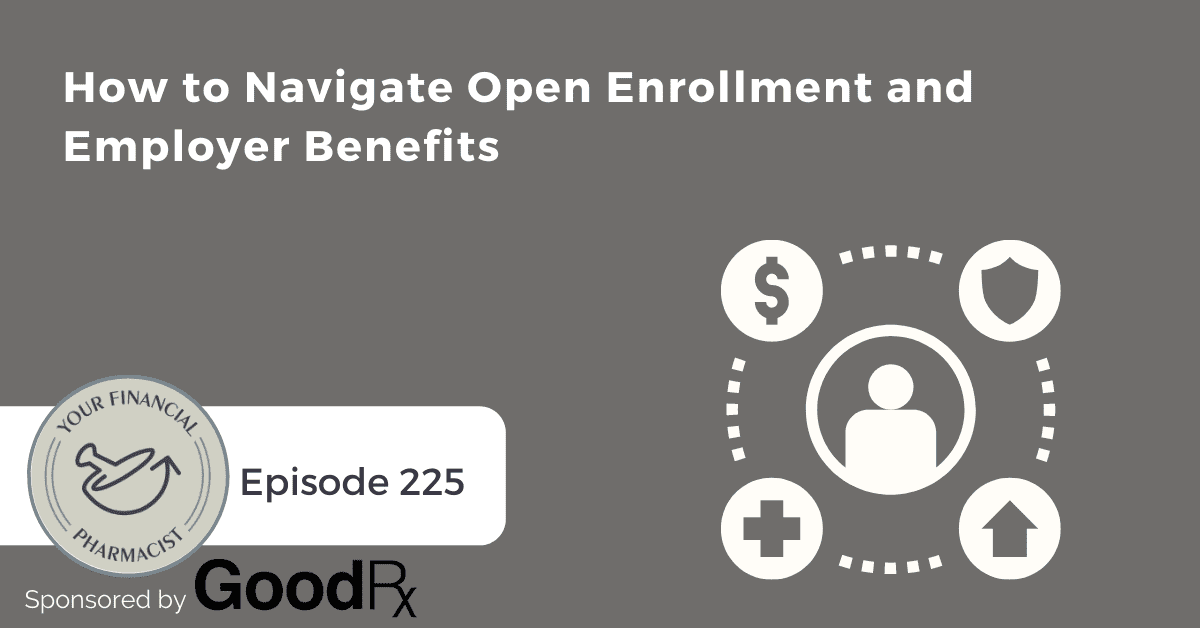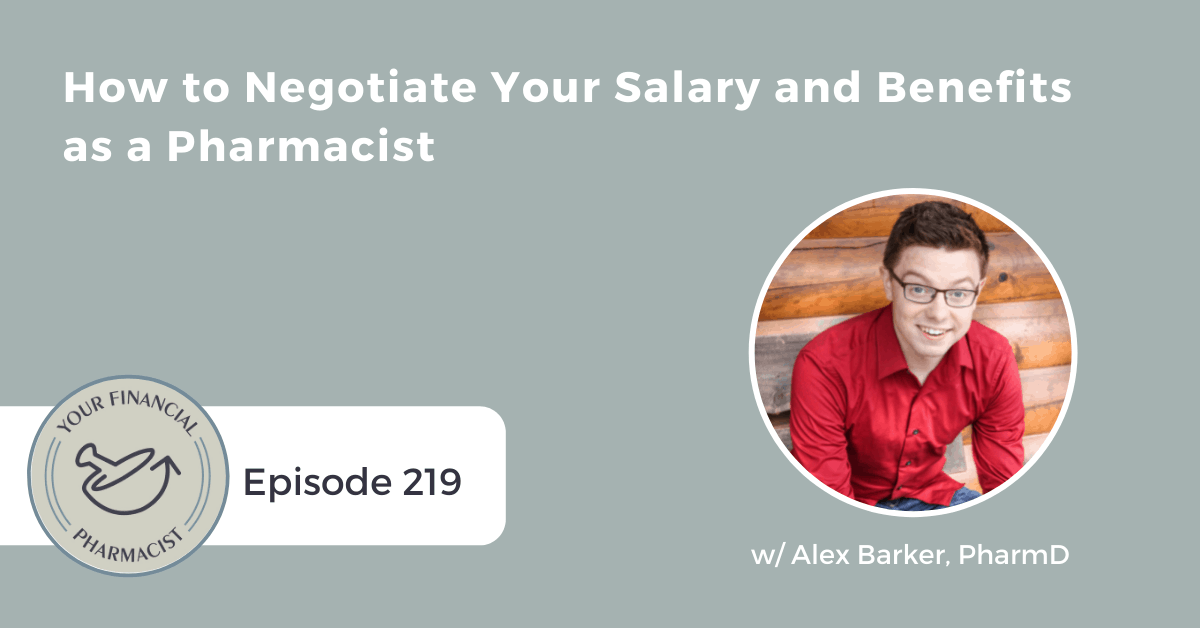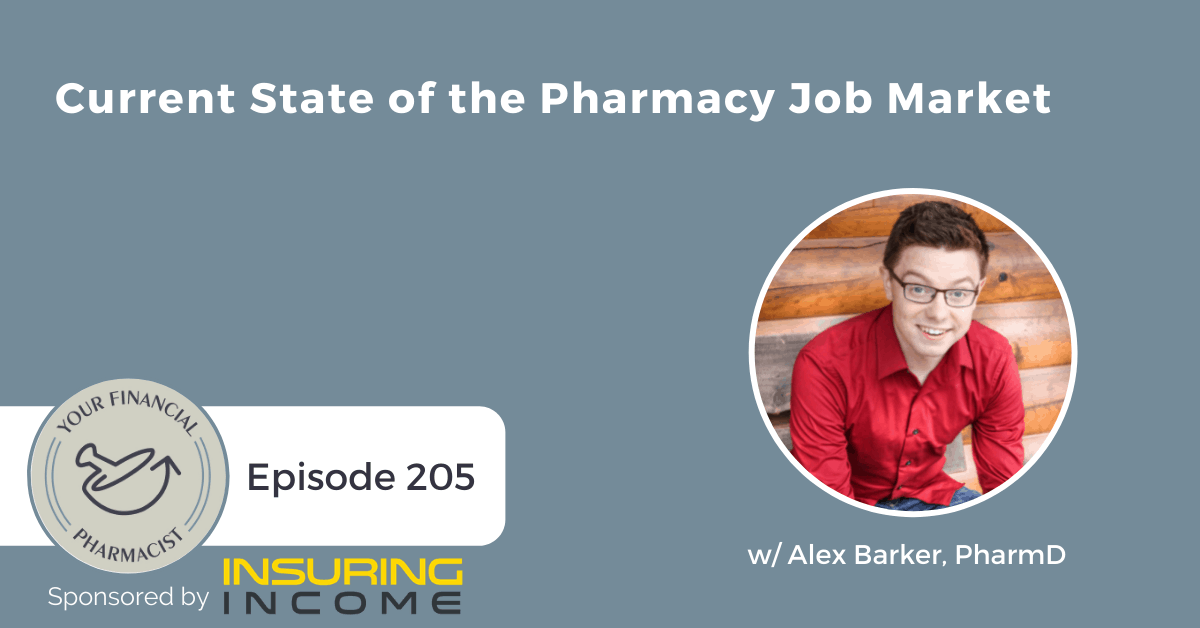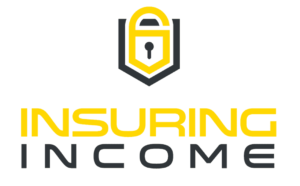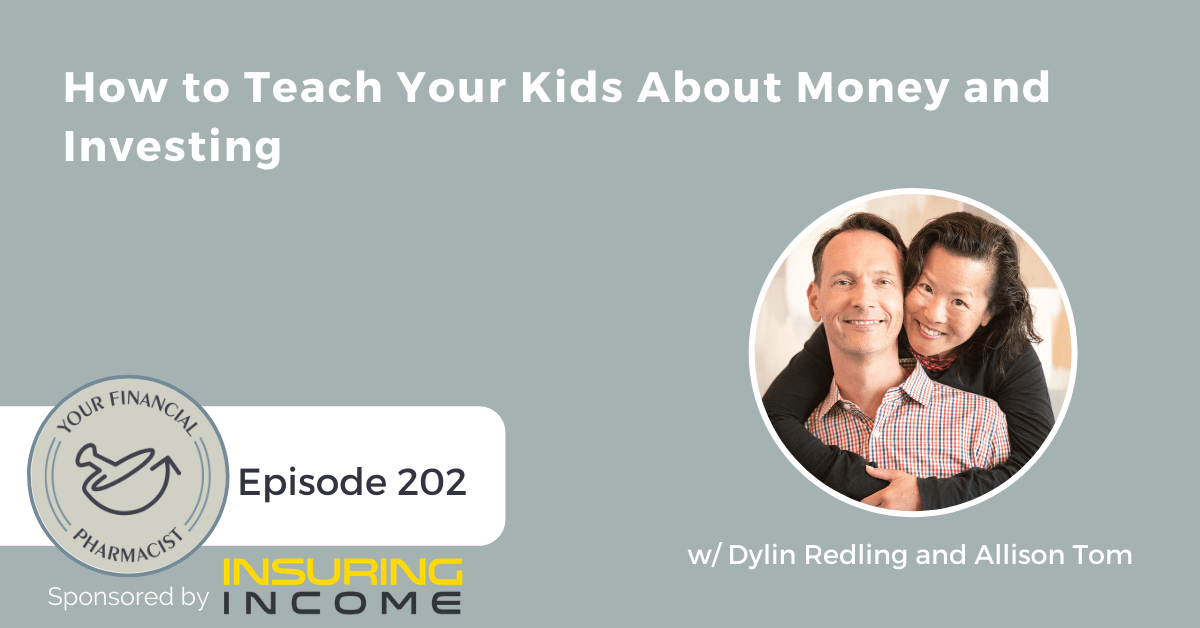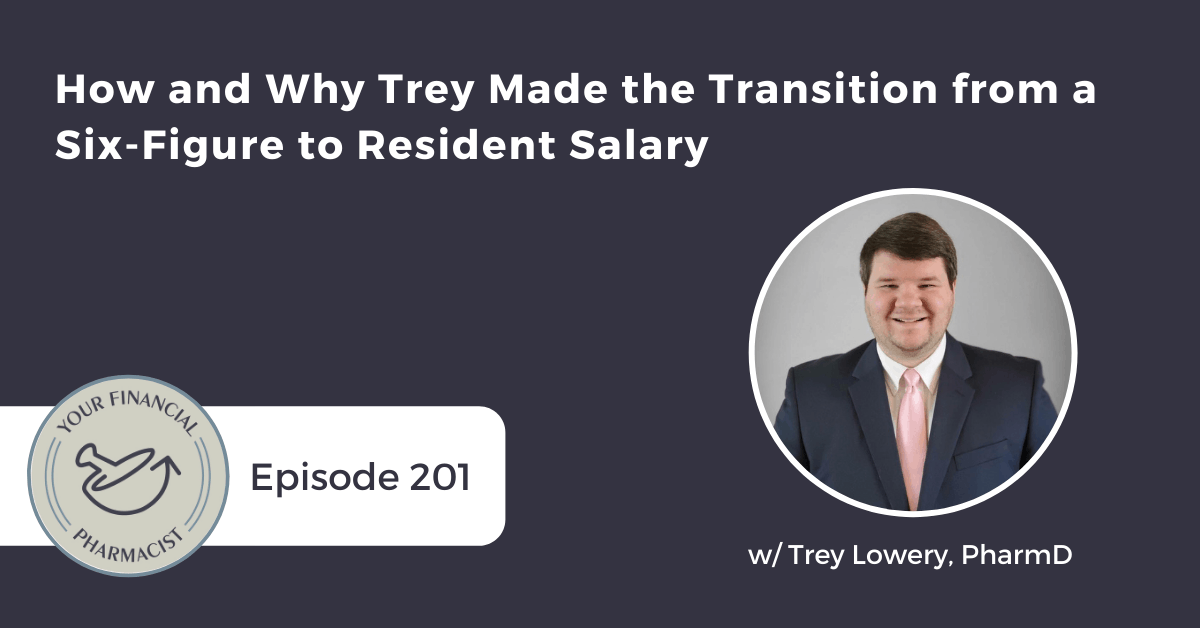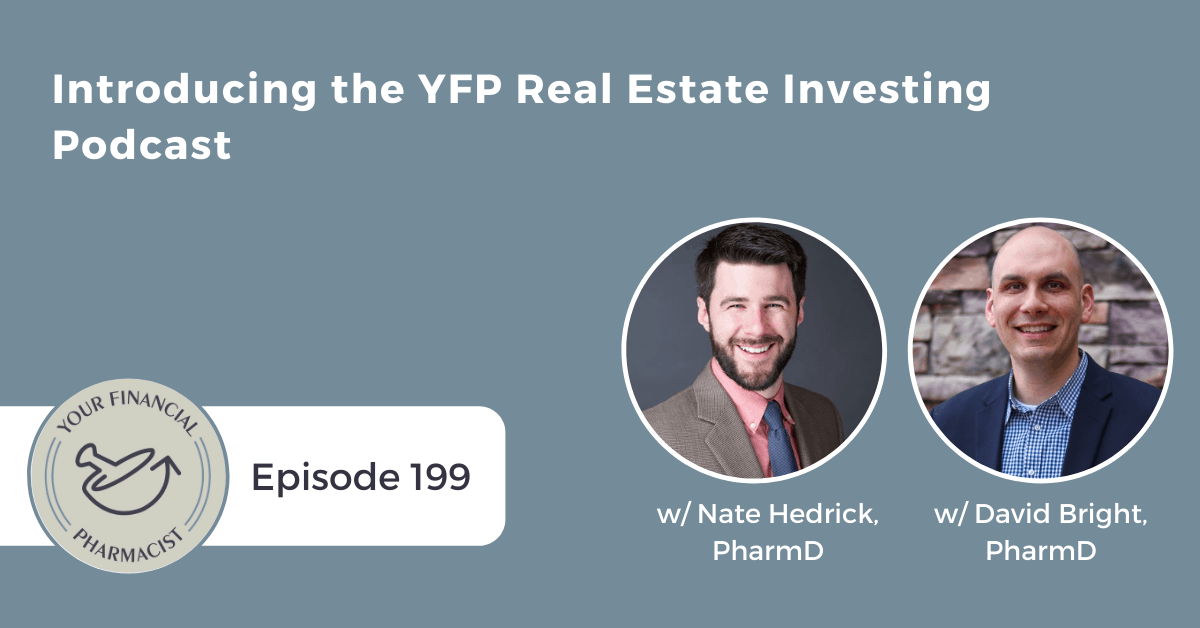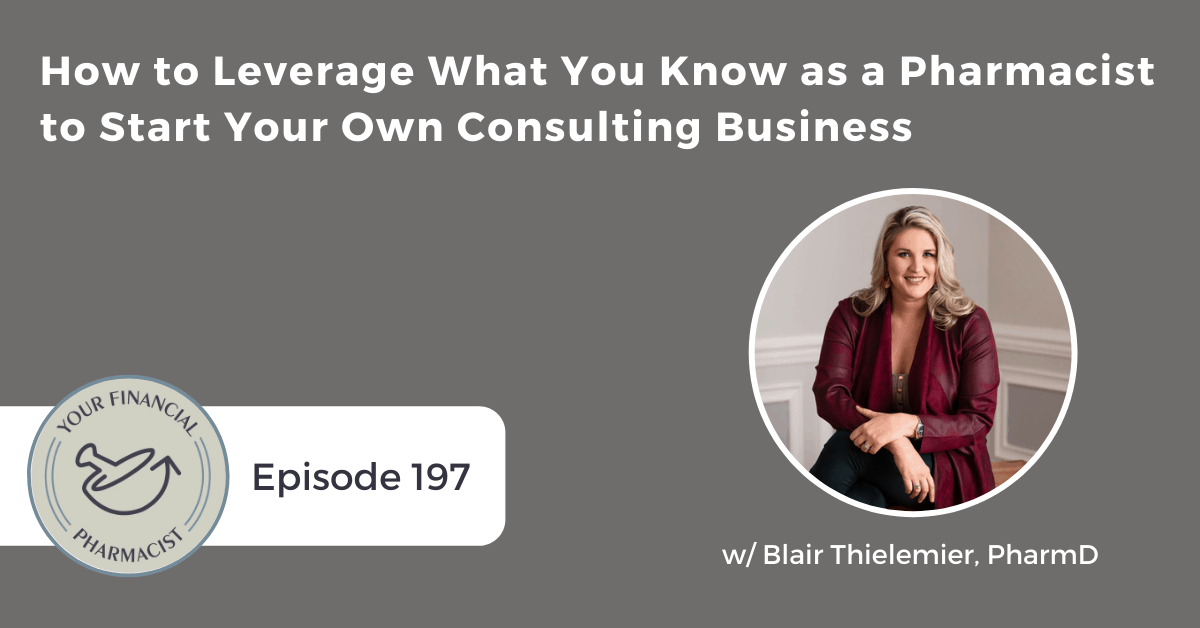Tax Moves to Consider Before 2022
On this episode, sponsored by APhA, Paul Eikenberg, YFP CFO and Director of YFP Tax, discusses how pharmacists can optimize their tax strategy.
Episode Summary
As we approach the end of the year and will soon enough find ourselves amid tax filing season, it’s a great time to revisit end-of-year tax strategies and considerations to optimize your tax situation. Today on the Your Financial Pharmacist Podcast, host Tim Ulbrich sits down with IRS enrolled agent and our own Director of YFP Tax, Paul Eikenberg, to discuss how pharmacists can optimize their tax strategy. Paul has supported hundreds of pharmacists in tax filing and tax planning to maximize their deductions and avoid overpaying. Today he kicks us off with the important distinction between tax planning and preparation, as well as why it’s worthwhile to understand key numbers such as marginal tax rates and AGI. You’ll hear him describe common tax blunders he sees pharmacists making and how to avoid them, including realizing an unexpected balance due on April 15. We cover some of the factors that contribute to that making non-qualified IRA or 401(k), 403(b) contributions and missing key deductions in credits, and the listener gets a look into the two exciting tax services we have on offer to help pharmacists looking for a tax preparation and/or tax strategy and planning solution. To top it off, we’ve even got a comprehensive tax checklist for you to get the absolute maximum out of your tax benefits. This is one conversation you don’t want to miss.
Key Points From This Episode
- Paul and Tim catch us up with some exciting happenings in the YFP tax team.
- Understanding the important difference between tax preparation and tax planning.
- Differentiating your marginal tax rate and effective tax rate as a decision-making tool.
- Paul explains the implications of AGI and how to arrive at that number.
- Touching on the complicated system of student loans and pursuing loan forgiveness.
- Some common tax blunders that you should look out for!
- Key credits and deductions that you might not be taking advantage of.
- What is going to be available moving forward with child-care and dependent care.
- Explaining donor-advised funds and a potential strategy around bunching.
- Two exciting tax services: reporting only and year-round planning and reporting
Highlights
“Make sure your tax exposure and your tax strategy line up with your financial goals. The biggest thing that tax planning really does is provide some peace of mind that you’re not making mistakes and that you’re making good decisions.” — Paul Eikenberg [0:08:05]
“Our best practices with YFP is to advise people to, instead of putting the money in the [retirement] funds during the course of the year, put it into an investment account.” — Paul Eikenberg [0:23:26]
“The rules on business expenses are, they have to be business-related, ordinary, necessary, and not extravagant. Ordinary is, if someone else is doing the same type of business, they’re going to have the same type of expenses necessary.” — Paul Eikenberg [0:25:09]
“The donor-advised fund makes it easy to [maximize tax benefits]. Then, you can spread that money out and make the donations from the fund you control. It’s like having your own foundation.” — Paul Eikenberg [0:34:36]
Links Mentioned in Today’s Episode
- Join the YFP Tax Waitlist
- Join APhA – Get 25% Off Your Membership with Code: YFP
- YFP 165: The Power of a Health Savings Account
- Why I’m Not Using My Health Savings Account to Pay for Medical Expenses
- YFP Planning: Financial Planning for Pharmacists
- Ask a YFP CFP #85: How can I maximize the tax benefits of donor advised funds?
- YFP 211: The Ins and Outs of the 529 College Savings Plan
- 7 Things to Consider Before Starting a 529 Plan
- Your Financial Pharmacist Disclaimer and Disclosures
End of Year Tax Checklist
- Project your income, taxes, and withholding
- Maximize your HSA contribution
- Know your FSA carryover limits and spend accordingly
- Consider 529 account contributions
- Document side business expenses – Mileage Logs**
- Have and execute a charitable contribution strategy
- Correct any over contributions to 401K/403B/IRAs
- Manage your capital gains
- Look for IRS Letter 6419 Advanced Child Credit & Notice 1444-C
- Have a system for organizing your tax documents
- Select & engage your tax preparation method
Episode Transcript
[INTRODUCTION]
[00:00:00] TU: Hey, everybody. Tim Ulbrich here, and thank you for listening to the YFP Podcast, where each week, we strive to inspire and encourage you on your path towards achieving financial freedom.
This week I had the chance to sit down with YFP Director of Tax and CFO, Paul Eikenberg to discuss how pharmacists can optimize their tax strategy. Paul’s an IRS enrolled agent and has supported hundreds of pharmacists in both tax filing and tax planning to maximize their deductions and avoid overpaying. As we approach the end of the year and will soon enough find ourselves in the midst of tax filing season, it’s a great time to revisit end-of-year strategies and considerations to optimize your tax situation.
Some of the highlights from my interview with Paul include him explaining the important distinction between tax planning and preparation, why it’s important to understand key numbers such as marginal tax rates and AGI. Hearing him describe common tax blunders he sees pharmacists making and how to avoid them. Some of these blunders include realizing an unexpected balance due on April 15, and some of the factors that contribute to that making non-qualified IRA or 401(k), 403(b) contributions, and missing key deductions in credits. Finally, hearing Paul’s end of the year to-do list, your notes already prepared and ready to go for you to take action.
Before we hear from today’s sponsor and then jump into the show, at YFP, we know that filing your taxes and figuring out how to optimize your tax strategy can be overwhelming and stressful. That’s why YFP Tax has opened up its tax filing services to 125 additional pharmacist households this year. Unlike other firms, YFP tax isn’t focused on just completing your tax return. Instead, they provide value care and attention to you and your taxes. Because they work specifically with pharmacists, they’re familiar with aspects of your financial plan to have an impact on your taxes like student loans, benefit packages, side hustles and more. You can visit yourfinancialpharmacist.com/tax to learn more and to put your name on the waitlist. Again, that’s yourfinancialpharmacist.com/tax.
Okay. Let’s hear from today’s sponsor and then we’ll jump into my interview with Paul Eikenberg.
Today’s episode of the Your Financial Pharmacist Podcast is brought to you by the American Pharmacists Association. APhA has partnered with Your Financial Pharmacist to deliver personalized financial education benefits for APhA members. Throughout the year, APhA will be hosting a number of exclusive webinars covering topics like student loan debt payoff strategies, home buying, investing, insurance needs and much more. Join APhA now to gain premier access to these educational resources and to receive discounts on YFP products and services. You can join APhA at a 25% discount by visiting pharmacist.com/join and using the coupon code, YFP. Again, that’s pharmacist.com/join using the coupon code, YFP.
[INTERVIEW]
[00:02:54] TU: Paul, glad to have you back on the show.
[00:02:57] PE: Hey, Tim. Good to be here.
[00:02:59] TU: Question, are you ready for another tax season? Feels like we – you, really, and the team just wrapped up things from last year. It’s been a busy year, right?
[00:03:07] PE: That’s how it feels too. We just finished October 15th, the last of our extensions and are trying to build the capacity this year to do all our internal returns and 125 more.
[00:03:22] TU: That’s exciting stuff. In addition to the work that you’re doing as the director of tax and leading that initiative at YFP, the team is also growing. We’ve got some folks that are coming on board. Tell us about those exciting developments.
[00:03:34] PE: Aurielle was coming on board full time this year. She worked with us last year as a contractor and I’ve worked with her in a previous business venture. Really excited to have her come on board, and help smooth out the processes and build capacity to do more returns. Then Ryan Griffin, who’s a pharmacist and loves to do taxes on the side is coming back this year and working with us again. We’ll be adding some – one or two other contractors that we’ve talked to this year are interested in joining our team. It should be a good group to increase the capacity and help us do a better job for more people.
[00:04:23] TU: I know. Tim and I are super grateful for your contributions to what has made the service that it is today for the other folks you mentioned, Arielle and Ryan. We really believe that tax for obvious reasons, we’re going to talk about much that on the show today is such an important thread of the financial plan. That tax planning and preparation is really best if we embed that into the financial plan and can consider that, both looking back in the filing as we’ll talk about, but also in more the planning, and look ahead and the strategy side of it.
That’s the theme for today’s show, how to optimize your tax situation. Great time, as I mentioned in the introduction, end of the calendar year. Some opportunities to wrap some things up, get some momentum in the new year. We’re going to talk through some of the differences of tax planning and prep, key numbers and terms to understand, some commonly made blunders. We’re certainly not going to address all of these. Some strategies and then a checklist of things to do before the end of the year.
Paul, kick us off. I think, really, with this first part which is the theme, as we think of the others, and this really highlights the intentionality of thinking about taxes. Not only looking backwards, and doing the filing, and the preparation, but also more of the proactive planning. Tell us about the difference between tax planning, tax preparation and why that difference is so important.
[00:05:44] PE: Tim, the way I like to look at it, tax preparation is just historically recording what happened last year. We as tax preparers take your information, prepare a return. There’s not much of an opportunity to have an impact on your tax liability. There may be a couple of things we can do when preparing your taxes that you can adjust before April 15th. But it’s really difficult to have much impact on the tax liability during that period of time. You have to understand that when you’re dealing with tax preparation, it’s really deadline driven. When we get into February, March, and April, we’re working every hour trying to complete returns, chase down information, review and file.
There’s not as much time to pay attention to what could have been done, look at future strategies and really think through how to improve the situation. One of the frustrating things on our end is, when you’re preparing a tax return, that’s the time a lot of problems pop up, and are discovered and it’s too late to fix a lot of times there.
You contrast that to thinking about tax planning’s forward focus. For our clients, we do a lot of tax projections in the middle of the year or towards the end of the year. That’s a great time to look for things that can have more impact on tax liability. It’s just like financial planning. If you’re making the right decisions, they compound over the course of years. Tax savings builds, it helps put more money in your investment and savings accounts. It can help you leverage the income you have if you’re making the right tax choices. The best time to do that is not during the tax filing season.
From planning, we help people avoid common mistakes. Make sure your tax exposure and your tax strategy lines up with your financial goals. The biggest thing that tax planning really does is provide some peace of mind that you’re not making mistakes and that you’re making good decisions about how you’re approaching all t he tools you have to mitigate your taxes.
[00:08:27] TU: Yeah. I think our community will appreciate working and living in the healthcare environment, where we see the importance and value of preventative health care versus that that’s more reactive. We think about tax preparation, got to do it, it’s required, right? Or else the IRS is going to come knocking on the door. The tax planning may not have that same priority in terms of that requirement, but so important in terms of that strategy and what that can mean to the rest of the financial plan. As well as Paul mentioned, the peace of mind.
Paul, as we think about key numbers that folks need to know, certainly there’s a lot that we could talk about here. But I think starting off with differentiating marginal tax rate and effective tax rate is really important because these are terms that we throw around. We’ll talk about AGI here in a moment, adjusted gross income. But I think when people are hearing about certain strategies and benefits, or maybe they’ve been told by a preparer before about what their tax rates are, may not have a full understanding of what that term means. And then what the implications are of how to use that or how helpful it is or is not as a decision-making tool. Define for us marginal tax rate versus effective tax rate, and specifically why that marginal rate is an important decision-making tool.
[00:09:40] PE: Well, let’s start with marginal rate. The marginal tax rate, think of it about as the percentage of tax you’re paying on the last dollar you earned and the next dollar you earned. There’s a lot of misconceptions on how the tax brackets work. Most pharmacists are in the 24% or 32% tax bracket. That doesn’t mean you pay 24% on all your income. You’re being taxed at 10% for some, 12% for the next layer, 22% for another layer and then you’re paying 24%. They average out to what’s commonly known as an effective tax rate. Think of effective as the average tax rate.
But the marginal rates, really the number when I talk to people, that’s the number I want them to remember. What is your marginal tax rate? Because that’s your decision-making number. If you want to make a charitable contribution, if you’re in a 24% federal tax bracket, $100, that’s deductible to a charity, you’re going to save $24 in tax. It helps make decisions on traditional versus Roth contributions. You’ll understand what the tax ramifications are.
Today, HSA contributions would save you in taxes. Just having that marginal tax rate, knowing what it is helps make a lot of decisions on earning more money, or how the deduction is going to affect you. When I talk to our clients, that’s one of the most important numbers I want them to remember is where they fall in that marginal tax rate.
[00:11:33] TU: In ballpark numbers, Paul, knowing that, of course, it’s dependent upon one situation, whether or not they live in a state where there is tax or is not. Ballpark numbers, what do you see in terms of many of the clients from a tax perspective of the marginal rate and the effective tax rate?
[00:11:52] PE: When we looked at federal alone, a high percentage of our clients are in the 24% marginal tax rate and see their effective rate in the 17%, 18% area. State taxes, you can live in Florida, Tennessee, Texas and you have zero income tax. California, you see people 9%, 10%. Maryland, when you add in the local tax, you’re up to eight. It’s everywhere between 0% and 10% for the states. You need to calculate that in with the federal for really what your marginal rates are going to be.
[00:12:40] TU: I think the other key number for folks to make sure we’re defining and thinking about the implications would be AGI. When I think of AGI, everyone has likely heard of whether it’s considerations around student loan payments, or phase-outs for certain credits or deductions. Often, those are referenced according to someone’s AGI and the phase-outs based on AGI or adjusted gross income. Paul, tell us what is the AGI. How does that connect to one’s income and what’s subtracted from the income to come up with the AGI and then some of the reasons why that AGI number is so important?
[00:13:18] PE: Let’s talk about what the income is. Gross income, you add all your wages, dividends, interest, if you have capital gains, side business income, any money you’re bringing in, typically gross income. They’re what’s known as above-the-line deductions. The most common things we see are HSA contributions, 401(k), 403(b) contributions. They reduce your AGI. Reduce that gross income, gives you the adjusted gross income. Teachers will see some educator expenses. Residents will see student loan interest that can come off of there. But those are commonly referred to as above-the-line reductions and affect the AGI. You take all that income, reduce them by the above-the-line deductions and you get your AGI.
Now, where we see that really come into effect are student loans, where payments are based on income and will also lower AGI, lowers your payments. Lower payments increase the value of the forgiveness program. They do have a big effect on a lot of pharmacists. It’s a number that we work with people to manage as best they can. Make sure they’re using all their tools to take advantage of those programs.
The other thing you’ll hear a lot are phase-outs. This year, the child credits get reduced when a married filing joint couple’s AGI is above $150,000. You start to phase out there. Child care credits, start phasing out or phasing down. They don’t phase out at $125,000 AGI.
There are a lot of things we see our clients are affected by AGI. There are cases where contributing a little bit more to an HSA or make more into a retirement program can not only affect that marginal rate you’re paying, but can substantially affect some of the credits that would be available to you. The other thing that AGI is a factor in, is your long-term capital gain rates. It’s an important number to manage and work into your tax strategy.
[00:16:03] TU: Yeah. Paul, a couple of things I want to highlight that you said that are really important. Your comment just a moment ago about depending on where you’re at with AGI and some of the phase-outs, it might be helpful to make an HSA contribution, 401(k), 403(b). Obviously, depends on someone’s personal situation. But that highlights what we just talked about a few moments ago of really the differentiation between the preparation and the planning.
If we’re simply going through that preparation and we realize what’s been – and perhaps it’s too late, maybe we make an adjustment for the future. But if we’re planning and proactively looking ahead, we have an opportunity to project where those rates are going to be. And then what are some of those levers that we could pull to really maximize that situation.
The other thing I want to mention to make sure we don’t gloss over, and I think we’ve done so much of this at clients at YFP Planning that perhaps we take it for granted, is that student loans for good reasons, they’re very complicated. Unfortunately, the system is probably more complicated than it needs to be. Tax preparers and accountants may not necessarily be really well versed in student loan repayment strategies, and the intersection of the student loan repayment strategy and tax planning and preparation. We’ve gotten that feedback so many times, of folks that may have talked with someone else and didn’t understand the student loans or got conflicting advice. I think, really making sure for folks specifically that are pursuing loan forgiveness, that you’re really considering how that tax strategy is interfacing with that student loan repayment. Because there are some situations that, filing separately versus filing jointly, that may not be intuitive from a traditional tax planning preparation standpoint, do make sense when it comes to loan forgiveness.
[00:17:41] PE: Yeah. It will almost always cost you more in taxes to file separate. But there are so many cases that we deal with the savings and the benefits on a student loan, just more than make up for it. Substantially more than make up for it in some cases.
[00:18:00] TU: Next thing. Paul. I want to pick your brain on was, some common tax blunders that you’ve seen and things that folks may be on the lookout for. We’re not going to go through an exhaustive list or we’d be here for a long time. But a few things I want to highlight, probably one of the more common things I think we see, and perhaps leads to some headaches for those that are going through the filing phase, is realizing that they were under withholding. Tell us about that, Paul, and why that may be and some of the things that folks can be thinking about to prevent that.
[00:18:33] PE: Yeah. It’s one of the more painful things for both the tax preparer, and the client is when you say, “I know you’ve got a $5,000 refund last year, but this year, you owe $5,000 in taxes.” We see big swings when maybe you got married this year, and your W-2 is now filled out, married, filing joint and it’s not filled out in a way that your employer takes into account your spouse’s income. If you switch jobs in the middle of the year, sometimes the W-4 just don’t match up and you’re under withheld. If you’re working side jobs, if you’re not completing that tax withholding form correctly, you’re employed, both your employers are not taking into account the wages you’re earning at that secondary job.
Multiple jobs, spouse’s earnings not being calculated in are common things. The other items that kind of cause and contribute to that is, maybe you have self-employment earnings and you’re not only got income tax on that, but you’ll have the self-employment tax. If you had capital gains or stock options, sometimes those are going to sneak up and cause a tax liability you weren’t thinking about. This year, you’ve really got to be prepared in thinking about, if you receive the advanced child credits since July, and your AGI is over that phase out, some of that money or all of that money is going to have to be repaid. There’s a chance you weren’t eligible for any of that. You really need to be prepared if you’re getting it and you know your income, your AGI is going to be over $150,000. You should be thinking through whether that might be causing you a problem.
[00:20:36] TU: We’re running out of time, Paul, for folks to opt-out of any of those payments, have they been receiving them.
[00:20:41] PE: December is the only one you can opt-out now, and I believe it’s November 29 that you have to do it by. Just be aware of that one hit. That could cause some unexpected problems.
[00:20:56] TU: Better to find out in November, December than March or April.
[00:20:59] PE: Yeah. That’s what we always say is, if we can identify the issue in October, November, we have six months to be ready for the tax bill. If you find out in March, we’ve got to be ready to pay it right then and there.
[00:21:16] TU: That being a common blunder, unexpected balance due on April 15 as you mentioned, less than ideal for both the preparer and the client. The other bucket here would be non-qualified IRA or 401(k), 403(b) contribution. So tell us more about how this happens and some of the headaches this can create.
[00:21:32] PE: Switching jobs or having multiple jobs is where we’ll see the 401(k), 403(b) contributions go over that 19-5 maximum. A lot of people just put the percentage in. If you work for the same employer all year, they usually stop at the maximum. But if you’ve got multiple employers, they are unaware of what amount the other one has put into it.
Usually, if you discover this before December 31, it’s not that difficult to have the funds given back. But W-2s can be adjusted properly and you avoid some of the more difficult and time-consuming ways to correct it, if you don’t discover it till the end of following season. Knowing that it’s a problem before the end of the year and getting it corrected can save penalties and save you from having to go through the amended returns.
With IRAs, with pharmacists, the phase-outs, it’s more than likely you’re phasing out on your ability to do traditional IRAs. There are limitations on SEP IRAs. There’s a misunderstanding of what the rules are on them. Especially the SEPs, you really don’t know until you do your tax return. How much you can contribute to a SEP is very common. We see people contribute to traditional IRAs. SEPs that are over what they can contribute. Roths as well, and there’s a lot of hoops to jump through to correct it after the fact, where it’s better – our best practices with YFP is to advise people to, instead of putting the money in the funds during the course of the year, put it into an investment account. When we get an exact number, which you qualify for, you’re able to put those in the IRAs up till April 15th and we can deal with actual numbers rather than guessing what you qualify for.
[00:23:53] TU: Then having to correct it later, potentially.
[00:23:55] PE: Yeah. We’ve had people that have had to file two, three years of abundant returns to correct over contributions to IRAs.
[00:24:06] TU: The third bucket of potential blunders would be missing deductions and credits, of course, that may be applicable to folks. There’s lots of deductions and credits to consider, whether that’s childcare credits, adoption credits, tuition deductions, property taxes, charitable contribution. We’re not going to go through all of those. But Paul, are there some of these that jump out of common ones that we see folks overlooking or not taking advantage of?
[00:24:31] PE: Yeah, refis in home purchases. A lot of times when you’re purchasing a home, you’re paying your property taxes in advance and that gets overlooked frequently. Are the property taxes paid at the time of settlement? If you did refi or have a home purchase, you want to have that settlement sheet available to go through and see if it helps with itemized deduction. Side business expenses, if you have a side hustle, document everything you think is a legitimate expense.
The rules on business expenses are, they have to be business-related, ordinary, necessary, and not extravagant. Ordinary is, if someone else is doing the same type of business, they’re going to have the same type of expenses necessary. If you think of it as anything you are spending to get customers or grow how much business they do with you, there’s the argument that that’s a legitimate business expense. Their cell phone, internet cost, some of your continuing education, are all things that can legitimately be switched to a schedule C business. Not all of it, but a percentage of it that you can make a case or business expenses.
Then, one of the things, if you’re not maxing out your HSA, you should be matching out your HSA. People leave dollars on the table with the HSA contributions.
[00:26:15] TU: I think it’s just a good reminder, Paul, as you mentioned, side hustle expenses and the guidelines in the IRS that they have to be business-related, ordinary, necessary, not extravagant. We’re seeing more and more clients at YFP Planning, more folks in the YFP community that are pursuing side hustles or generating additional income from the W-2 income. Certainly, something to be thinking about and planning for, again, hopefully proactively. Which is a good segue into talking about some strategies to optimize one’s tax situation. You’ve already mentioned a couple and we’ve talked about some of these at length on other episodes.
You mentioned HSAs as low-hanging fruit. We’ve talked before about HSAs in the podcast. We’ll link to that in the show notes. You mentioned the side hustle expenses, and we talked briefly about the child tax credit. A couple others that I would like to focus on, Paul, starting with the child care credit, since this was an increase that we saw in 2021 and may be applicable for many that are listening. Tell us about that child care credit and the changes that we’ve seen this year.
[00:27:15] PE: Yeah. This was part of the recovery program. Right now, it’s only been increased for 2021. But you know, we expect that the next legislation that comes through is going – this is going to be a prime factor in it. Child care costs in 2020, you were able to take a credit for up to $3,000 for one child, $6,000 for two or more children. Most pharmacists qualified for 20% credit on those. Two kids, you are qualified to get up to a $1,200 credit. 2021, the amount that the credit is based on it is now $8,000 for one child, or $16,000 for two or more. Maximum credit is $3,200 for most pharmacists this year. For the child care credit, in 2021, you’re going to be looking at probably a 20% credit on $16,000 of expenses, $3,200 hours. Most pharmacists with two children or more. That’s what’s going to be available.
It’s a substantial increase in the amount of credit that’s available and it reflects – it better reflects the actual cost of childcare that we see, then that $3,000 and $6,000 power plant. That’s going to be a good benefit to a lot of the clients we work with. The other thing to look at is the dependent care FSA. That’s a great benefit that we see available to pharmacists that a lot of them are taking advantage of. But you can shift. The limit was $5,000. It was increased to a maximum of $10,500 that can be taken out of your wages and reimburse you for the child care expenses. The advantage of doing it this way, over taking the credit is, if you’re in a higher marginal tax rate, then the 20%. It’s better to have it in the dependent care FSA.
The other big advantage there, two advantages is, it reduces your AGI. The money that is withheld from the W-2 is not subject to the FICA tax. You could save another 7.65% there. It’s a great program if your employer offers it. Not all employers have increased the limit to $10,500. You really need to check what’s available to you through your employer. But if you have it, and you’re paying child care expenses, take advantage of it.
[00:30:09] TU: I’ve heard you say before, Paul, this is one of the more underutilized benefits that we see. Obviously, for those listening that have children, between the childcare credit, the dependent care FSA changes and the child tax credit, lots to consider here. And making sure we’re taking advantage of some of those opportunities.
[00:30:24] PE: Definitely.
[00:30:25] TU: The other thing too, and we won’t go into detail on today’s show, because we’ve talked about it several different times in the podcast related to 529s. But again, on the theme here of children and the context of college savings, that’s another optimization strategy to consider. Obviously, taking advantage of some of the state tax considerations and benefits there. We’ll link to previous content and 529 in the show notes.
Paul, I do want to wrap up this section on benefits talking about a topic that we have not talked about in detail on this show. Tim Baker and I did a question on ask YFP CFP on donor-advised funds, but we didn’t get into the strategy of bunching and some of the nuances of the donor-advised fund. For those that are looking at charitable giving opportunities, tell us more about what is a donor-advised fund and what is the potential strategy around bunching versus not bunching.
[00:31:19] PE: Donor-advised fund is an account you can set up, [inaudible 0:31:26] have an account. There’s a lot of faith-based organizations that have donor-advised funds available. But basically, you make your charitable contribution to that fund. Then you’re the one that controls how it is distributed from there, and it can be distributed over a period of years. It’s tax-deductible in the year you put money in. But it’s an opportunity, it gives you some tax advantages and gives you an opportunity to be more strategic about how you give.
One of the things that it does is, it makes donating appreciated assets easy. I have a fun setup and I can donate stock that I’ve had a significant gain on. When I do that, I’m not paying capital gains tax on the stock I’m donating. Let’s say I paid $5,000 for a stock that’s now worth $10,000. I get a $10,000 charitable deduction when I switch that over. I don’t pay $5,000 capital gain tax. It is one of the best ways to maximize the power of your donations to do more with less.
Donor-advised funds makes that easy and all that money is deductible when it goes in there. Now, that becomes a big advantage when you start talking about a bunching strategy. A lot of people, when the 2018 tax change came in and the standard deduction was raised, are kind of on the edge of being able to itemize or not itemize. When we talk about a bunching strategy, it’s, let’s say bunching charitable contributions in odd years. Instead of making a $5,000 contribution in 2021 and 2022, I’ll make a $10,000 contribution to the donor-advised fund in 2021. I get all of that $10,000 deductible in that 2021 year. That may put me $5,000 over the itemized deduction limit. The next year I take a standard deduction.
It is possible, without changing the amount of money donated in those two years, that I get an additional $5,000 worth of the standard and itemized deduction added together for the two years. Could be as much as $5,000 more than if I donate the money $5,000 one year and $5,000 the next.
[00:34:28] TU: Just by grouping those together, the dollar amount didn’t change, but putting them together maximizes the tax benefits.
[00:34:35] PE: Yeah. The donor-advised fund makes it easy to do that. Then, you can spread that money out and make the donations from the fund you control. It’s like having your own foundation. There are a lot of different options out there. There’s different investment opportunities with the money in it. There can be minimums, some different costs. But you put money in there, the capital gains on money left in there grow without tax. We see people who have stock options that have gone through the roof, can really do an amount of good, and wind up 50 cents on a $1, sometimes, of being able to increase the value of their contributions by that much.
[00:35:29] TU: My hope, Paul as we’re hitting the surface on several different optimization strategies is that folks aren’t feeling overwhelmed, but hopefully an opportunity to say, “Wow! How can I better strategize my tax situation?” I think this again, comes full circle and highlights the benefit of really more of the strategy side of the tax binding in addition to making sure we get that preparation taken care of.
We’ve got a checklist of things that we think you should be thinking about before the end of the year. We’re going to link to these in the show notes. These include much of what we talked about on the show around HSAs, and thinking about FSA carryover limits, 529 contributions, side business expenses, capital gains, preparing for the tax preparation phase, organizing documents. We’re going to put that list in the show notes, which will hopefully help wrap up the year and head into the new year with some confidence. I think that’s a good segue, Paul into what we are offering at YFP tax as two different options to help pharmacists that are looking for a tax preparation, and/or tax strategy and planning solution.
Paul, tell us more about our two options, the reporting only, and the year-round planning and reporting, and what folks can expect from that service and where one or the other may be a good fit.
[00:36:47] PE: We kind of talked about in the beginning, the tax preparation reporting only is just doing your historical tax return and meeting with you and just talking about is there anything you can do that may change the tax situation for the year. The reporting only is good for, if all your income is coming from W-2, if you don’t have a business or planning on having one soon, don’t have real estate income or any substantial retirement or investment accounts, at this point, all your income comes from inside the country, that may be a good fit for you. You’re really not getting the expert advice, you’re getting preparation and kind of basic information on what happened last year and not so much of the future. That’s a fee. We’ll have a base fee, and if you require additional schedules, there may be additional cost if you move from one state to another, maybe some additional costs. It’s more flat lay transaction, we prepare your taxes.
What we’re introducing this year is a year-round planning, which, if you’re self-employed, if you’re thinking about starting a business, have that side business, if you get K-1s from partnerships or LLC, real estate holdings, if your investments have grown and your retirement accounts are nearing that $100,000 mark, maybe there’s things that you’ll have options that somebody else may not. Multiple streams of income, income from outside the US, these are all things that probably point you in the direction of needing a year-round planner.
The expert advice will have a bigger effect on your situation, and having a long-term partner to help you reach your goals. That’s kind of what we’re positioning to work with you on a continuous basis. When we do this, we’ll meet with you, do the taxes and the tax review. We’ll talk about the upcoming years as well as last year. We’ll meet with you during the course of the year to do a projection of where you are and talk about things that we can do in the third quarter, fourth quarter to prepare and make sure we’re ready for the following year. With that, we’ll have a team available when you have questions during the course of the year to answer those questions. That is where we’re geared to have the most impact for clients and pharmacists that want to work with us. I think that we’re well situated and prepared to be a long-term partner and that’s what we’re looking to do.
[00:39:54] TU: Again, two options we have, as Paul outlined, the reporting only and the year-round planning and reporting. More information about both, you can find at yourfinancilpharmacist.com/tax. We’re excited to be opening up the tax services to 125 pharmacist households. First come first serve. Many may already be aware that we do tax planning preparation for those that are clients of YFP planning. We’re going to be opening up these 125 spots to those that are not currently clients as we’ll be doing that work already for those that are clients. Process works and go to yourfinancialpharmacist.com/tax to learn more information. You can join the waitlist.
Early January, we’ll be sending out an engagement letter. You can then upload your documents, complete a questionnaire. We are a paperless tax processing and system. Then from there, there’ll be a completion of a preliminary return and then an opportunity to review that information, sign it and then e-file it.
More information in yourfinancialpharmacist.com/tax. Paul, grateful for your time, expertise contributions on the show and looking forward to the upcoming tax season.
[00:41:02] PE: Thanks, Tim.
[OUTRO]
[00:41:03] TU: Before we wrap up today’s episode of Your Financial Pharmacist Podcast, I want to again thank our sponsor, the American Pharmacists Association. APhA is every pharmacist ally advocating on your behalf to address the issues that are affecting you most, such as PBM, and payment reform, value over volume and provider status. Make sure to join a boulder APhA to gain premier access to financial educational resources and to receive discounts on YFP products and services. You can join APhA at a 25% discount by visiting pharmacist.com/join and using the coupon code, YFP. Again, that’s pharmacist.com/join, using the coupon code, YFP.
As we conclude this week’s podcast, an important reminder that the content on this show is provided to you for informational purposes only and is not intended to provide and should not be relied on for investment or any other advice. Information in the podcast and corresponding material should not be construed as a solicitation or offer to buy or sell any investment or related financial products. We urge listeners to consult with a financial advisor with respect to any investment.
Furthermore, the information contained in our archive, newsletters, blog post and podcast is not updated and may not be accurate at the time you listen to it on the podcast. Opinions and analyses expressed herein are solely those of Your Financial Pharmacist, unless otherwise noted and constitute judgments as of the dates published. Such information may contain forward-looking statements, which are not intended to be guarantees of future events. Actual results could differ materially from those anticipated in the forward-looking statements.
For more information, please visit yourfinancialpharmacist.com/disclaimer. Thank you again for your support of the Your Financial Pharmacist podcast. Have a great rest of your week.
[END]
Current Student Loan Refinance Offers
[wptb id="15454" not found ]Recent Posts
[pt_view id=”f651872qnv”]

